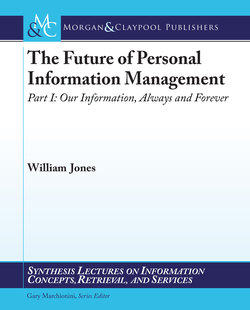Читать книгу The Future of Personal Information Management, Part 1 - William Jones - Страница 9
ОглавлениеPreface
All of my work, going back to my doctoral research into human memory long ago at Carnegie-Mellon University, has been motivated by the observation that information—at the right place and time, in the right form, and coherently organized—can help us to be very smart. Conversely, information missing or messy can overwhelm and make us stupid. How can we use information and information tools as an extension of ourselves and according to the lives we want to live?
Who should read this book? I wrote the book for the following audiences:
Faculty who are teaching PIM-related courses who can use the book both for a review of PIM basics and also to stimulate discussions concerning the future of our devices and the Web (Chapters 3 and 4).
People in PIM research who can use the book as an update on PIM-related research and perspectives.
People in related/contributing fields—including human-computer interaction (HCI), information retrieval (IR), library and information science (LIS), artificial intelligence (AI), database management, cognitive psychology and cognitive science – who can use the book as an efficient way to get up to speed on PIM.
People in business who want to know “what they should know” about PIM especially as it relates to employee productivity and the criteria for the selection of supporting tools. The book can’t hope to be current with respect to supporting tools of PIM, but will provide guidelines for selecting PIM tools, techniques and policies.
Interested laypeople who want to know more about the field of PIM and who also hope to improve their own practices of PIM.
Some notes and caveats about this book:
• References to scholarly articles of direct relevance to personal information management (PIM) are grouped together into a bibliography at the end of the book (Part I). Web references and references for non-PIM background reading are generally included directly in footnotes.
• I include no references to information you can easily find on the Web. Instead of references, I sometimes include suggested search terms.
• I am an unabashed citer of Wikipedia (http://www.wikipedia.org/) articles when these are reasonably clear and objectively written. The interested reader should use these articles not as a final destination but as a springboard (through references cited) for further study of a given topic.
• The book is not a step-by-step “how to.” It aims to help you in your efforts to figure things out for yourself.
• The book is not a review of the latest and greatest in PIM tools and technologies. Such a book is out of date even as it is being written.
• This book is no crystal ball. Instead, the book makes reasonable extrapolations from present trends into the future. Also, the book considers a “present perfect” of basic truths concerning our ways of processing information that have, are and likely always will, have relevance.
William Jones
March 2012
